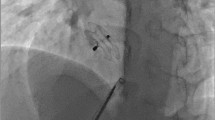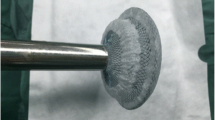Summary
Over the last few years, various devices for the interventional closure of atrial septal defects (ASD) up to a diameter of 20mm have been developed. We report our clinical experience in closing ASD with a diameter larger than 20mm diameter with the Amplatzer Septal Occluder (ASO).¶ Method: The stretched diameter of the ASD was measured by inflating a sizing balloon within the defect until an indentation in the circumference in the balloon could be observed. An ASO with a stent diameter 2–4mm larger than the indentation in the circumference of the balloon was chosen and implanted via 9–12 French sheaths. In contrast to the closure of smaller defects, pullback of the device onto the atrial septum was only performed when the connecting stent of the ASO was completely deployed in order to achieve maximal centering characteristics and optimal support of the retention skirt of the left atrial disc on the edges of the defect. Only then was the right atrial disc deployed and actively configured by advancing the sheath and the delivery cable against the atrial septum. Implantation was only attempted if the atrial septal rims (except the anterior rim around the aorta) measured more than 7mm by echocardiography to avoid injury or disturbance of sensitive intracardiac structures. After placement, the fixation of the device and the mechanical stability was proven by an extensive “Minnesota wiggle”. The ASO was released only when TEE showed no or a trivial residual color flow through the connecting stent; otherwise repositioning was performed.¶ Results: Out of 352 patients (P) with successful closure of interatrial defects, 70 P (age: 1.1–77.3 years) had stretched defects larger than 20mm diameter (median 22mm diameter (20–36), 25/75% quartiles=20/26mm). Mean shunt size was Qp:Qs 2.1:1 (0.7–3.9:1), mean fluoroscopy time 10.9min (0–63). Complete closure could be achieved in 85.7/93.1/100% after 3 months, ¶1 and 2 years, respectively. Besides 3P with persistent atrial fibrillation, only 5 P showed transient atrial tachyarrhythmias, 2 only periprocedural and 3 within the first 3months after implantation were treated with β-blocker. In one patient, an acute embolization of the device occurred because a diminished posterior rim was not visualized by a monoplane TEE probe necessitating surgical explantation and defect occlusion. Despite oversizing the device, no “mushrooming” misconfiguration were observed.¶ Conclusion: Transcatheter closure of large atrial septal defects with the Amplatzer Septal Occluder is feasible, safe and effective. Risk of complications do not seem to occur more frequently than after closure of smaller defects if one adheres to certain sizing and implantation measures. The incidence of transient atrial tachyarrhythmias seems to be low.
Zusammenfassung
Viele verschiedene Systeme für den Verschluss von Vorhofseptumdefekten (ASD) kamen in den letzten Jahren zum Einsatz, deren Gebrauch meist auf Defektgrößen bis 20mm Durchmesser limitiert war. Wir berichten über unsere klinische Erfahrung beim Verschluss von ASD mit einem Durchmesser größer 20 mm mit dem Amplatzer Septal Occluder (ASO).¶ Methode: Ein im Defekt platzierter Ballonocclusionskatheter wurde soweit inflatiert, dass eine Kerbe im Ballon als Grundlage für die echokardiografische als auch radiologische Bestimmung des gedehnten Durchmessers entsteht. Ein ASO¶2–4mm größer als der gedehnte Durchmesser wurde durch 9–12 French messende lange Schleusen implantiert. Im Unterschied zum Verschluss kleinerer Defekte wurde der ASO erst nach vollständiger Entwicklung des linksatrialen Schirmchens und des Verbindungsstents unter Ausnutzung der maximalen Auflagerungsfläche und Zentrierungseigenschaft in den Defekt gezogen, danach der rechtsatriale Schirm entfaltet und durch zügiges Vorschieben der Schleuse und des Implantationsdrahtes in Richtung Septum aktiv konfiguriert. Eine Implantation wurde nur durchgeführt, wenn der den Defekt umgebende Rand außer aortal, anterior minimal 7mm maß. Nach Implantation wurde mit einem extensiven „Minnesota wiggle” die mechanische Stabilität des ASO überprüft. Eine Freisetzung erfolgte nur, wenn kein oder nur minimaler Restshunt durch den zentralen Verbindungsstent im Farbdoppler zu erkennen war, ansonsten erfolgte eine konsequente Repositionierung.¶ Ergebnisse: Von 352 Patienten (P) mit interventionellem ASD-Verschluss mit einem ASO hatten 70 P (Alter 1,1–77,3 J) einen Defekt größer 20 mm (Median 22 mm (20–36), 25/75% Quartile = 20/26 mm). Der mittlere Shunt betrug Qp:Qs 2,1:1 (0,7–3,9:1), mittlere Durchleuchtungszeit 10,9 min (0–63). Ein vollständiger Verschluss war bei 85,7/93,1/100% der P nach 3 Monaten, ¶1 und 2 Jahren zu beobachten. Außer den 3 P mit chronischem Vorhofflimmern hatten nur 5P passagere Arrhythmien, 2 periprozedural und 3 innerhalb der ersten 3 Monate nach Verschluss, behandelt mit β-Blocker. Bei einem P kam es wegen eines ungenügend ausgebildeten posterioren Randes zur Akutembolisation des ASO mit nachfolgender chirurgischer Explantation und Defektverschluss. Trotz des „Überdimensionierens” des ASO kam es zu keiner Fehlkonfiguration des Implantats.¶ Schlussfolgerung: Der Verschluss von Vorhofseptumdefekten mit einem Durchmesser größer 20mm ist ohne höhere Komplikationsrate sicher und effektiv durchführbar, wenn man die modifizierten Implantationskriterien berücksichtigt. Passagere Arrhythmien stellen keine besondere Problematik dar.
Similar content being viewed by others
Author information
Authors and Affiliations
Additional information
Eingegangen: 21. März 2000/Akzeptiert: 5. Juli 2000
Rights and permissions
About this article
Cite this article
Berger, F., Ewert, P., Dähnert, I. et al. Interventioneller Verschluss von Vorhofseptumdefekten mit einem Duchmesser größer als 20mm. Z Kardiol 89, 1119–1125 (2000). https://doi.org/10.1007/s003920070139
Issue Date:
DOI: https://doi.org/10.1007/s003920070139




